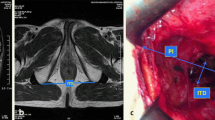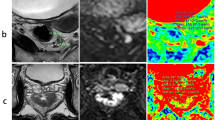Abstract
Purpose
We aimed to clarify the impact of the apparent diffusion coefficient (ADC) value of the mesorectum from preoperative magnetic resonance imaging (MRI) on surgical difficulty in laparoscopic anterior resection (Lap-AR) for rectal cancer.
Methods
In total, 67 patients who had undergone curative Lap-AR for rectal cancer in our hospital from January 2008 to March 2015 and had preoperative MRI findings available were included. We randomly calculated the average ADC in three regions of the mesorectum at the level of the upper edge of the superior border of the femur. Univariate and multivariate analyses were performed to evaluate the correlation between the patients’ clinicopathological characteristics, including the ADC value and short-term surgical outcomes.
Results
The univariate analysis revealed that a lower ADC value was associated with a significantly increased operative blood loss (p = 0.008) and prolonged operative time (p < 0.001). The multivariate analysis adjusted for the body mass index, anal verge, tumor location, covering stoma, clinical T factor and conversion revealed that the ADC value was an independent risk factor for a prolonged operative time (R2 = 0.6003, p < 0.001). Furthermore, the multivariate analysis adjusted for the body mass index, anal verge, covering stoma, clinical T factor and conversion revealed that the ADC value was an independent risk factor for an increased blood loss (R2 = 0.4345, p = 0.008).
Conclusion
A lower ADC value of the mesorectum might be a predictor of surgical difficulty in Lap-AR for rectal cancer.

Similar content being viewed by others
References
Braga M, Vignali A, Gianotti L, Zuliani W, Radaelli G, Gruarin P, Dellabona P, Di Carlo V. Laparoscopic versus open colorectal surgery: a randomized trial on short-term outcome. Ann Surg. 2012;236:759–66.
Seki Y, Ohue M, Sekimoto M, Takiguchi S, Takemasa I, Ikeda M, et al. Evaluation of the technical difficulty performing laparoscopic resection of a rectosigmoid carcinoma: visceral fat reflects technical difficulty more accurately than body mass index. Surg Endosc. 2007;21(6):929–34.
Mack LA, Temple WJ. Education is the key to quality of surgery for rectal cancer. Eur J Surg Oncol. 2005;31:636–44.
den Dulk M, Collette L, van de Velde CJ, Marijnen CA, Calais G, Mineur L, et al. Quality of surgery in T3–4 rectal cancer: involvement of circumferential resection margin not influenced by preoperative treatment. Results from EORTC trial 22921. Eur J Cancer. 2007;43:1821–8.
Comber H, Sharp L, Timmons A, Keane FB. Quality of rectal cancer surgery and its relationship to surgeon and hospital caseload: a population-based study. Colorectal Dis. 2012;14:e692–700.
Beets-Tan RG. MRI in rectal cancer: the T stage and circumferential resection margin. Colorectal Dis. 2003;5:392–5.
Beets-Tan RG, Beets GL. Rectal cancer: review with emphasis on MR imaging. Radiology. 2004;232:335–46.
Bammer R. Basic principles of diffusion-weighted imaging. Eur J Radiol. 2003;45:169–84.
Lyng H, Haraldseth O, Rofstad EK. Measurement of cell density and necrotic fraction in human melanoma xenografts by diffusion weighted magnetic resonance imaging. Magn Reson Med. 2000;43:828–36.
Onur MR, Poyraz AK, Bozdag PG, Onder S, Aygun C. Diffusion weighted MRI in chronic viral hepatitis: correlation between ADC values and histopathological scores. Insights Imaging. 2013;4:339–45.
Choi MH, Oh SN, Rha SE, Choi J-I, Lee SH, Jang HS, et al. Diffusion-weighted imaging: apparent diffusion coefficient histogram analysis for detecting pathologic complete response to chemoradiotherapy in locally advanced rectal cancer. J Magn Reson Imaging. 2016;44(1):212–20.
Curvo-Semedo L, Lambregts DM, Maas M, Beets, GL, Caseiro-Alves F, Beets-Tan RG. Diffusion-weighted MRI in rectal cancer: apparent diffusion coefficient as a potential noninvasive marker of tumor aggressiveness. J Magn Reson Imaging. 2012;35:1365–71.
Yiqun S, Tong T, Cai S, Bi R, Xin C, Gu Y. Apparent diffusion coefficient value: a potential imaging biomarker that reflects the biological features of rectal cancer. PLoS One. 2014;9(10):e109371. https://doi.org/10.1371/journal.pone.0109371.
Lambrecht M, Deroose C, Roels S, Vandecaveye V, Penninckx F, Sagaert X, et al. The use of FDG-PET/CT and diffusion-weighted magnetic resonance imaging for response prediction before, during and after preoperative chemoradiotherapy for rectal cancer. Acta Oncol. 2010;49:956–63.
Sun YS, Zhang XP, Tang L, Ji JF, GU J, Cai Y, et al. Locally advanced rectal carcinoma treated with preoperative chemotherapy and radiation therapy: preliminary analysis of diffusion-weighted MR imaging for early detection of tumor histopathologic downstaging. Radiology. 2009;254:170–8.
Dzik-Jurasz A, Domenig C, George M, Wolber J, Padhani A, Brown G, et al. Diffusion MRI for prediction of response of rectal cancer to chemoradiation. Lancet. 2002;360:307–8.
DeVries AF, Kremser C, Hein PA, Griebel J, Krezcy A, Ofner D, et al. Tumor microcirculation and diffusion predict therapy outcome for primary rectal carcinoma. Int J Radiat Oncol Biol Phys. 2003;56:958–65.
Kim SH, Lee JY, Lee JM, Han JK, Choi BI. Apparent diffusion coefficient for evaluating tumor response to neoadjuvant chemoradiation therapy for locally advanced rectal cancer. Eur Radiol. 2011;21:987–95.
Heo S, Jeong S, Young J. A comparative study of histopathologic parameters and apparent diffusion coefficient values on 3T rectal MRI in locally advanced rectal cancer following neoadjuvant chemoradiation therapy (abstr). In: European congress of radiology (ECR) annual meeting program, Vienna, Austria. 2010.
Kim YC, Lim JS, Keum KC, Kim KA, Myoung S, Shin SJ, et al. Comparison of diffusion- weighted MRI and MR volumetry in the evaluation of early treatment outcomes after preoperative chemoradiotherapy for locally advanced rectal cancer. J Magn Reson Imaging. 2011;34:570–6.
Schmid-Tannwald C, Schmid-Tannwald CM, Morelli JN, Albert NL, Braunagel M, Trumm C, Reiser MF, Erti-Wagner B, Rist C. The role of diffusion-weighted MRI in assessment of inflammatory bowel disease. Abdom Radiol (NY). 2016;41(8):1484–94.
Oto A, Zhu F, Kulkarni K, Karczmar GS, Turner JR, Rubin D. Evaluation of diffusion-weighted MR imaging for detection of bowel inflammation in patients with Crohn’s disease. Acad Radiol. 2009;16(5):597–603.
Stanescu-Siegmund N, Nimsch Y, Wunderlich AP, Wagner M, Meier R, Junchems MS, Beer M, Schmidt SA. Quantification of inflammatory activity in patients with Crohn’s disease using diffusion weighted imaging (DWI) in MR enteroclysis and MR enterography. Acta Radiol. 2017;58(3):264–71.
Funding
None.
Author information
Authors and Affiliations
Contributions
HS and MT contributed equally to all aspects of this study. HS and MT participated in its design and coordination and helped draft the manuscript. KO, TI and YA participated in the design of the study and performed the statistical analysis. SO guided me in the measurement of imaging (i.e., apparent diffusion coefficient). HH and YK conceived of the study, participated in its design and coordination and helped to draft the manuscript.
Corresponding author
Ethics declarations
Conflict of interest
The authors declare that they have no competing interest.
Rights and permissions
About this article
Cite this article
Suzumura, H., Tsuruta, M., Hasegawa, H. et al. The impact of the mesorectal apparent diffusion coefficient value on surgical difficulty in laparoscopic anterior resection for rectal cancer. Surg Today 49, 239–244 (2019). https://doi.org/10.1007/s00595-018-1727-7
Received:
Accepted:
Published:
Issue Date:
DOI: https://doi.org/10.1007/s00595-018-1727-7




